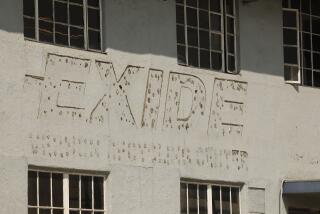Base Fights Toxic Gas Additive With Bacterial Warfare
- Share via
PORT HUENEME — When it comes to pollution, bacteria may be the Navy’s best friend.
Faced with a 39-acre underground plume of a toxic gas additive at Port Hueneme Naval Construction Battalion Center, a coalition of Navy, university and oil company scientists is testing a new environmental cleanup method that uses an enriched bacterial culture called BC-4.
“This is absolutely the first application in the ground for this technology,” said Paul Johnson, a professor of civil and environmental engineering at Arizona State University. “Everyone in the petroleum industry is waiting to see what happens out here.”
Microorganisms have been used for breaking down gasoline and other compounds in the past, but the suspected-carcinogen MTBE, originally added to make fuel burn cleaner, is a different beast entirely. Unlike the other major pollutants in gasoline, MTBE dissolves easily in water, moves quickly and breaks down slowly.
The additive is widely used in Southern California, and scientists estimate that 70% of gasoline in the U.S. contains the controversial substance.
Several universities are working on efforts to combat the additive, but participants say the Port Hueneme project--funded by Shell Oil Co. and staffed by university and Navy scientists--is on the cutting edge.
Shell developed BC-4 into what it is today--a microorganism devoted solely to eating MTBE. The bacteria is injected into the contaminated aquifer under the Navy base.
Johnson said initial results from recent sampling are promising. Decreased levels of MTBE provide hope that the bacterial “bugs” in BC-4 are breaking down the toxic additive into water, carbon dioxide and other harmless substances.
Environmentalists may also be waiting to see what happens with the 4,015-foot plume of MTBE, or methyl tertiary-butyl ether. The additive has been found in concentrations of up to 200,000 parts per billion--well over the proposed drinking-water standard of about 14 parts per billion--and is moving toward the ocean at an estimated rate of half a foot to a foot a day.
Several California cities, including Santa Monica and South Lake Tahoe, have closed drinking water wells because of MTBE contamination. Environmentalists are pushing for a ban on the substance, and at least one major oil company has backed away from its use.
Since the contaminated aquifer is not used for drinking water and the plume is still about 2,900 feet from harbor waters, base officials say there is little reason for concern. But they admit that the extent of the contamination caught them off guard.
“It has traveled significantly farther than we ever envisioned,” said Ernest Lory, manager of the National Test Site, an ongoing pollution-control program being run by the Naval Facilities Engineering Service Center.
Scientists at the center discovered the MTBE problem in 1995, nearly a decade after they first found evidence that 11,000 gallons of gasoline had leaked from an on-base refueling station.
But officials say the discovery of the MTBE plume was a benefit of sorts, because the Port Hueneme test site--one of four nationwide that are dedicated to combating pollution--concentrates on fuel hydrocarbon pollution. That makes it a perfect place to study MTBE.
“It’s kind of a blessing and a curse that we have this plume,” said Gail Pringle, an environmental protection specialist at the test site. “It presents sort of a researcher’s dream.”
Arizona State scientist Johnson agreed that the test site is vital for the research.
“If we were to try to do the same thing at a service station, it would be impossible,” he said.
Officials say partnerships among the Navy, universities and private industry are becoming increasingly common at Port Hueneme and other military bases across the country.
“More and more of it is going on,” Pringle said. “Environmental-cleanup technology and the actual cleanup are pretty expensive sometimes. It’s a way of not having one party bear all the burden.”
The situation is definitely a boon to Shell Oil, which Johnson estimated has spent about $1 million developing BC-4. MTBE is seen as the biggest threat posed by gasoline leaks at service stations.
A spokesman for Consumers for a Better Environment, a San Francisco-based nonprofit group that filed suit seeking to ban MTBE in August, applauded the company’s involvement but questioned its motives.
“Obviously, everybody is supporting finding a way to clean it up, but only if the solution we’re getting toward is banning MTBE,” said Denny Larson, the group’s Northern California director.
“If the goal of the study is to keep on using it and clean up our mess when we’re done, that’s unacceptable.”
More to Read
Sign up for Essential California
The most important California stories and recommendations in your inbox every morning.
You may occasionally receive promotional content from the Los Angeles Times.










